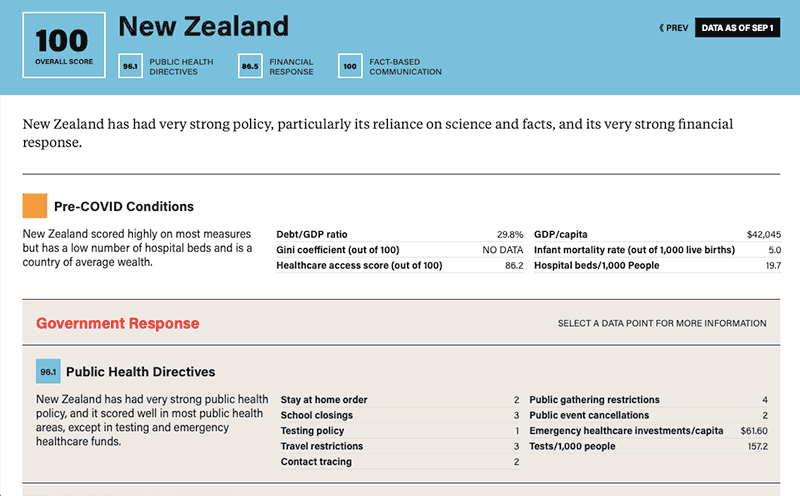Western democracies may lose the coronavirus propaganda war, but China certainly won’t win it.
- 85.9 Public Health
Directives - 22.3 Financial
Response - 4 Fact-Based
Communication
China’s aggressive lockdowns played a key role in controlling case and death rates. However, its low score is driven by multiple factors, including the country’s minimal financial response and lack of press freedom and fact-based communications. China’s failure to report testing obscures understanding of actual COVID-19 dynamics within the country.
Pre-COVID Conditions
Despite one of the best debt-to-GDP ratios, China’s relative underinvestment in healthcare infrastructure pre-COVID—notably hospital beds—limited its capacity to rapidly respond immediately to the crisis.
- Debt/GDP ratio 50.6%
- GDP/capita $20,984
- Gini coefficient (out of 100) 38.5
- Infant mortality rate (out of 1,000 live births) 7
- Healthcare access score (out of 100) 74.2
- Hospital beds/1,000 People 29.9
Government Response
Select a data point for more information(Data points represent policy level as of Sep 1.)
Public Health Directives
Strict stay-at-home orders issued on February 1st mitigated a worse spread of the virus and helped drive China’s relatively strong public health policy, though its limited emergency healthcare spending and testing policy push its score slightly lower.
- Stay at home order 3
- Public gathering restrictions 4
- School closings 3
- Public event cancellations 2
- Testing policy 3
- Emergency healthcare investments/capita $14.45
- Travel restrictions 3
- Tests/1,000 people NO DATA
- Contact tracing 2
Financial Response
China’s stimulus package was limited and provided minimal debt relief or income support, resulting in a relatively weak score.
- Financial stimulus as share of GDP 4.5%
- Income support 1
- Debt forebearance 1
Fact-Based Communication
China’s government has promoted factually incorrect information about COVID-19 and has limited press reporting on the pandemic.
- Reliance on science/fact based information 3
- Press freedom 3
COVID-19 Status as of Sep 1
China’s early, restrictive lockdown likely contributed to it having among the lowest death and case rates in the Index, based on CCP reporting. However, China has not reported any official data on testing, and given its limited use of facts and press limitations, it is unclear how reliable these numbers are.
- Total deaths 4,723
- Death rate per 100K 3.3
- Total cases 89,914
- Cases per 100K 63
- Percent of positive tests NO DATA
| Date | Status | New Cases/1M | |
|---|---|---|---|
| 1 | Apr 08 | Wuhan lockdown ends | 0.05 |
| 2 | Jul 19 | Urumqi (Xinjian capital) enters lockdown | 0.04 |
Differentiating Factors
- Wartime Mode in Xinjiang meeting resistance: While much of China has re-opened from COVID-19 lockdowns, the 22 million residents of the Western region of Xinjiang—half of whom are Uighurs—remain under severe lockdown and surveilled by community officials and auxiliary police. Read More
- Vaccine potential faces headwinds: Chinese companies are among the leaders in the development of a COVID-19 vaccines, but may struggle to find the thousands of participants necessary for Phase III trials and will face intense scrutiny given the country's opaque regulatory system, limited disclosure of data, and previous vaccine scandals. Read More
- COVID-19 could worsen inequality: The pandemic is likely to exacerbate inequality in China, which spends just 3 percent of its annual GDP on social welfare programs like unemployment insurance and affordable housing. By comparison, most developed countries spend 12 percent of GDP. Read More
- Limited transparency over data: China has a history of opaque governance that prioritizes stability over transparency, resulting in mutual distrust between the public and authorities, and raising questions about the accuracy of its published COVID-19 data. Read More
- Out-of-pocket expenses hitting the vulnerable: China's healthcare is largely private, with out-of-pocket expenses three times as high as the U.S. average, hindering widespread access to medical care. Read More
Compared with Neighboring Countries
-
69.1India 3,691,166
Cases 2,675
Per 1M 65,228
DeathsIndia scores just above the median, a large drop-off in recent months, keyed by substantial weakening of restrictions and worsening financial support.
-
88Japan 68,392
Cases 541
Per 1M 1,296
DeathsJapan has a strong overall score, driven by its generous financial response and a reliance on facts, although its public health policy is very weak.
-
40.5South Korea 20,182
Cases 394
Per 1M 324
DeathsSouth Korea has a relatively strong score, brought down some by its very weak financial policy; its public health score is likely underestimated here, given the data’s limitations to adequately account for the impacts of the country’s advanced contact tracing.
Further Reading From Foreign Policy
Be the source of actionable insight.
Select one of the subscription options below to read the full Covid-19 Global Response Index. Unlock even more global intelligence with a subscription to FP Insider.
Already an FP Insider? Log In
Looking for group access? Contact us directly

Statistics and government response factors available on each country profile include:
Pre-COVID Conditions:
- Debt to GDP ratio
- Infant mortality rates
- Hospital beds per 1,000 people
- Gini coefficients measuring inequality
- Health access and quality
COVID-19 Public Health Directives:
- Stay-at home orders
- School-closing policy
- Public-gathering restrictions
- Cancellation of public events
- Testing policy and rates per 1,000 people
- Emergency healthcare spending per capita
- Travel restrictions
- Contact tracing
COVID-19 Financial Response:
- Stimulus package as a share of GDP
- Income support
- Debt-forbearance
Public Communications:
- Instances of misinformation by leadership
- Limitations on press freedom, censorship
Current/Historic In-Country COVID-19 Status:
- Death rates per 1 million
- Case rates per 1 million





